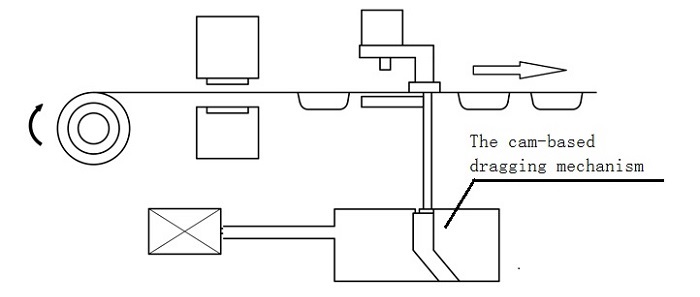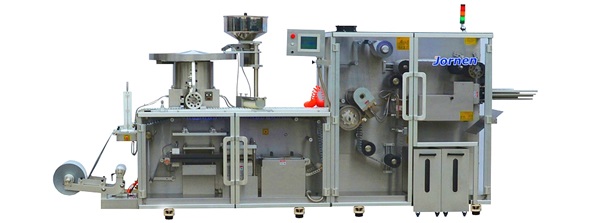Development Trends of Blister Packaging Machine
The Blister Packaging Machine, a kind of commonly used pharmaceutical packaging equipment, is widely used for pharmaceutical packaging. This paper will introduce the development trends of the pharmaceutical Blister Packaging Machine in automation, high speed, diversification and intelligence, from the perspective of the history of automatic packaging equipment and the demands for packaging machinery, and in combination with specific examples.The current trend of automation shows that packaging automation is not just a campaign or logic concept; it involves the integration of packaging and production lines. Thus, the global package manufacturers put forward the requirements for system automation, integrated control and programmable automatic control.In fact, the automatic packaging equipment has been developed to the fourth generation.First generation: mechanical automation, including one main motor, gear box, chain, etc., to transfer the power and torque.Second generation: basic mechanical automation technology and key motion servo control.Third generation: electronic servo control, with precision and synchronized multi-axis motion, variable-speed operation, high flexibility and accuracy and more and more applications.Fourth generation (also the current development trend): (1) based on the standard hardware and software and good extensibility, such as the full integration with the MES system (Manufacturing Execution System, mostly used as the execution part of the ERP resource planning system on the production site, to transfer production site data to the ERP system); (2) online integration, simplified operation and diagnosis and integrating production and packaging; and (3) application distributed intelligent technology, improving the productivity, reliability, stability and communication capabilities.Therefore, the technologically advanced countries in the world also attach great importance to the development trend of packaging equipment.German packaging machinery manufacturers takes five actions to adapt to customer demands: (1) greatly improving the process automation; (2) improving the productivity and reduce process costs; (3) adapting to the changes and designing flexible equipment; (4) providing complete sets of equipment and services; and (5) widely applying the computer simulation design technology.The American packaging machinery industry advocates: (1) automation of packaging machinery; (2) high efficiency and energy conservation; (3) diversified and multi-purpose packaging; (4) more convenient and safer packaging; and (5) application of new technologies.To sum up, the development trends of pharmaceutical packaging machinery and equipment, which also fall into packaging equipment, are automation, high efficiency/energy conservation, diversification and intelligence. The blister packaging machine is a type of typical and commonly used pharmaceutical packaging equipment. The development of the blister packaging machine is introduced below from the perspectives of automation, high speed, diversification and intelligence and in combination with specific examples.1. AutomationIn the production process, as a higher speed and precision is required for the Blister Machine, , intelligent control should be applied so as to meet the increasing requirement for flexibility, stability and reliability1.1 Intelligent servoFigure 1 shows the cam-based dragging mechanism of Jornen old-generation DPP250D series Blister Machines, in which packaging materials are conveyed slowly and the feeding length is adjusted mechanically, resulting in low efficiency and failure to meet the needs for rapid replacement of production varieties.Figure 1:

Figure 2 shows the servo dragging mechanism of our DPP260 series Blister Machines. Compared with the cam structure, the servo feeding mechanism has the characteristics of rapid running, accurate positioning, flexible adjustment of feeding length, etc.Figure 2:

Figure 3 shows the 300 and 120 blister packaging lines of Jornen, in which the Blister Machine is integrated with the Cartoning Machine to maximize the productivity.


Figure 4 shows Uhlmann Blister Express Center 300, in which a Blister Machine and a Cartoning Machine are integrated into one production line, subject to full servo driving. As the traceability system is installed, the drug supply chain can be traced without loopholes.Figure 4:

2. Rapid developmentThe increase of productive profits and reduction of costs are closely related to the improvement of production efficiency, while the operating speed of equipment and the rapid changeover and cleaning can improve the production efficiency. To maximize the production speed and minimize the auxiliary time, rapid replacement of mould without tools should be applied in the blister packaging process, to achieve the purpose of “plug and play”.Figure 5 shows the Jornen DPP260Ki-2 blister packaging machine, involving pneumatic positioning, mould locking, achieve extremely straightforward changeover.Figure 5:

The management mechanism of servo motor control + industrial computer is applied to automatically reset the original parameters.Figure 6 shows Jornen DPH260 high-speed blister machine, with the productivity up to 600 blisters/minute. If the blister machine is connected with the high-speed continue motion Cartoning Machine into one blister line, the production efficiency of 300 cartons/minute can be achieved.Figure 6:

3. Diversified developmentIn order to achieve the multi-variety and small-batch production mode, the Blister Machine should have good flexibility for flexible and rapid changeover of multiple varieties. Yield flexibility: the mass production of a single variety and small-batch production of multiple varieties can be achieved, and the single-lane or multi-lane requirements can be satisfied. Flexibility of machine structure: the whole equipment has a modular structure, and one or more module(s) can be replaced to adapt to product changes and maximize the flexibility and convenience, such as applicability to packaging products (types, shapes, sizes, etc.) and packaging materials (PVC-alu and alu-alu). The feeder adapting to different drug shapes can be used for accurately filling standard round, dual-convex, oval and multi-sided tablets, and even for filling a variety of tablets in one blister card.4. Intelligent developmentWith the development of science and technology, packaging machinery is being improved in terms of yield and flexibility, and the latest computer and network information intelligent technologies will also be applied. The future packaging machinery will have the such functions as remote maintenance, remote diagnosis, integration with the company’s ERP system, production data evaluation, automatic fault diagnosis and recovery, etc.In addition to the above-mentioned trends of automation, high speed, diversification and intelligence, the Blister Machine will be significantly improved in respect of safety, energy conservation and environment protection, to protect the personal safety of operators, minimize the energy consumption and the adverse influence of production on the environment. 30-03-2017
